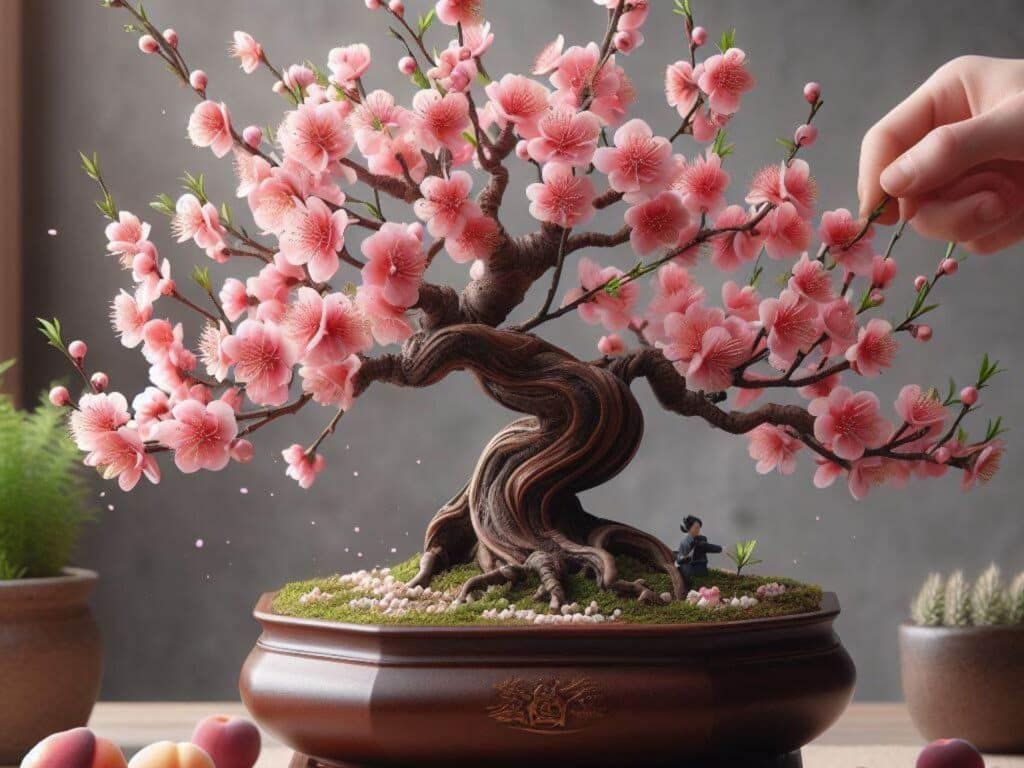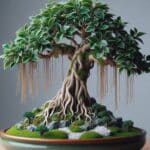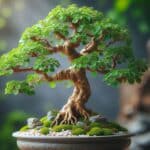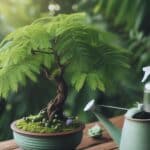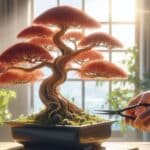Peach trees can make gorgeous bonsai trees but are not the easiest to grow or care for. Patience is required since these trees are slow growers and must be carefully monitored for pests and diseases.
If you do, however, manage to grow one of these trees, you will be richly rewarded because the mini trees can look striking when they bloom in late winter or early spring, and they can even bear fruit.
Let’s look at how to grow and care for these small trees and find out if you should try this bonsai journey.
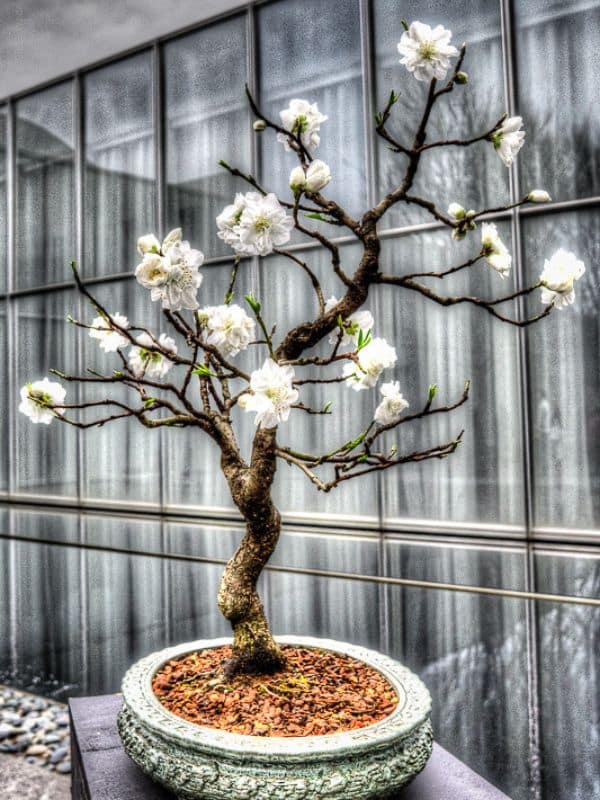
Plant Facts
| Scientific name | Prunus persica |
| Common names | Peach tree, bonsai peach |
| Family | Rosaceae |
| Plant Type | Fruit tree |
| Height and Width | 4–6 ft. tall (indoors), 1–3 ft. wide (indoors) |
| Origin | China and Persia |
| Flower colors | Pink |
| Foliage color | Dark green |
| Sun Exposure | Direct sunlight |
| Soil Type & pH | Well-drained loam soil |
| Special features | Beautiful blooms and produce fruits |
What Does a Bonsai Peach Tree Look Like
Peach bonsai are miniaturized versions of adult peach trees, but their leaves and flowers tend to be oversized in scale. They also produce full-sized fruits, and the number of fruits they bear needs to be restricted.
The deciduous trees will become dormant for winter and be most beautiful in late winter or early spring because they will produce many pink flowers. These fruit trees are vigorously green throughout the growing season.
Where Does a Bonsai Peach Tree Grow
All fruit trees are outdoor bonsai. They can be kept indoors in a windowsill with lots of direct sunlight, but they probably will only bloom or produce fruit if they are kept outside. If you do keep the little tree inside, then you will need to place it under a grow light, and you will need to enhance the humidity around your tree with a humidity tray.
How to Grow a Peach Bonsai
Fruit trees, as with any other standard bonsai tree, need to be pruned, kept in a small container, potted, fertilized, and wired, and their roots need to be pruned to shape and keep them small. Here are the steps for growing a peach bonsai.
Propagation
Peach trees can be propagated from seed, cuttings, grafting, or budding. Grafting and budding can be complex, but growing a tree from seed or cuttings is easy.
How to Grow a Peach Tree from Seed
Buy some fresh peaches and enjoy these tasty fruits. Keep the pits and remove all fruit bits with a brush and some water. Let the pit sit for a couple of days to dry out completely. You can now crack open the hard exterior to retrieve the peach seed.
The peach seed should be planted in a quality growing mix. It is best to plant the seed outside before winter to go through a cold dormancy stage. Germination can take four to six weeks after the dormancy stage, and you can gradually acclimate the sprout outdoors and expose it to more sunlight as it grows and becomes stronger.
How to Grow a Peach Tree from Cuttings
Take a couple of 9-inch cuttings in spring during the growing season. Cut the cutting at a 45-degree angle about an inch below the node and remove all the bottom leaves of the cutting. You can now dip the cutting in rooting hormone and plant it in a sterile potting medium.
Keep the cutting moist for a few weeks. Roots can start to develop in about a month. Keep the strongest cutting for your flowering bonsai tree.
Soil
Peach trees can be vulnerable to root rot. They should be planted in a lightweight, loamy soil that drains well. The soil should also be rich in organic materials with lots of nitrogen to boost leaf development. Soil with a pH level of 6 – 6.5 is ideal.
A good quality bonsai soil mixture with low water retention (a little bit less peat moss and more gravel) should work fine for your fruit tree bonsai.
Pruning and Training
Your little tree must be pruned and trained to stay small and look beautiful.
To prune the little tree, you can start by topping off the sapling or cutting to encourage more branching. Once the tree has a few branches, you can trim away any diseased, damaged, ingrown, or unwanted branches. Overly large leaves can also be trimmed away so the tree will appear more miniaturized.
After pruning the tree, it is best to wire the remaining branches to train it into a beautiful bonsai shape. Some of the best bonsai shapes for a peach tree are informal upright (Moyogi), Slanting (Shakkan), Windswept (Fukinagashi), or a simple umbrella shape.
You can use copper or aluminum bonsai wire and coil these wires loosely around any branches that you want to shape or modify. Gently push the branches into shape and allow the tree to rest for a few months before removing the wires.
Repotting and Transplanting
A bonsai fruit tree should be repotted every 1 – 3 years. Mature trees can stay in the same pot for 5 years before repotting them. It is best to repot your tree during its growing season and right after blooming. If the tree is repotted during its bloom cycle, it will shed all of its flowers. Repotting during its dormancy stage isn’t recommended because the tree might not have enough energy to survive.
Start by preparing the container. The new bonsai pot should have large drainage holes and be bigger and deeper because these trees need to be planted a bit deeper or their roots might not survive.
Install a mesh layer at the base of the container so the soil won’t filter out when you water your tree. Next, you can layer the bonsai pot with gravel to encourage proper drainage.
Before planting, trim one-third of the bonsai tree’s root system. Start by cutting away overly large roots and any diseased or damaged roots.
Add bonsai soil mix to the container and firmly plant your little tree. Keep the plant moist and away from direct sunlight for a few weeks until the tree stabilizes and starts sprouting new growths.
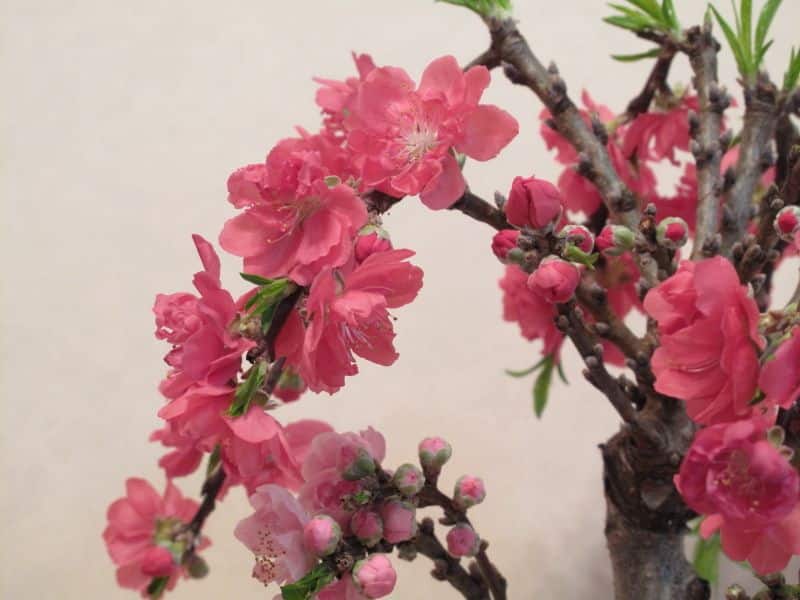
How to Care for a Peach Bonsai Tree
After growing and planting your mini tree, you must take good care of it. Bonsai plants require a little more care than your average fruit tree. Here is a quick look at how to care for this type of semi-dwarf tree.
Water
If you have good sandy soil that drains well, then you can water the little tree regularly. If the soil retains water, you can water your tree more infrequently, like once every 10 days. Be careful not to overwater the little tree since this can cause root rot or increase diseases.
Keep your tree on a strict watering cycle because if it becomes too dry, the roots can burn, or the tree might not grow well.
Sunlight
The small tree won’t grow well if it doesn’t get enough direct sunlight. It is best to keep the small tree outside where it will get 6 – 8 hours of direct sunlight. In particularly warm regions, the tree can be placed in a partial sun position because too much direct sunlight can make the fruits overripe or taste unpleasant.
Temperature and Humidity
Bonsai peach trees grow best at about 70 degrees, and their roots or pots should stay relatively warm at over 55 degrees F. At low temperatures, you can bring your tree indoors to protect it. If you want to keep the tree outdoors all the time, select a variety that requires chill hours that fall within your winter season.
The trees prefer a 40 – 50 percent humidity level. If the tree is kept indoors during winter, then you should increase humidity levels manually with a spray bottle or by placing the tree in a humidity tray.
Fertilizer
Most bonsai artists will avoid using a peach tree for bonsai because they can be very vulnerable to pests and diseases. If you have a peach tree, you should regularly inspect it for the following problems.
Pest and Diseases
Most bonsai artists will avoid using a peach tree for bonsai because they can be very vulnerable to pests and diseases. If you have a peach tree then you should regularly inspect it for the following problems.
Anthracnose
Anthracnose is a type of fungus that causes yellow and brown spots on the foliage and stems. To treat this problem, you will need to prune away any affected parts of the plant and treat the tree with a copper-based pesticide during its dormancy stage. This spray can cause leaf loss if it is applied during the growing season.
Powdery Mildew
Powdery mildew usually looks like white fluffy matter on the leaves. This disease can be caused by excess water or high humidity levels. You can treat this condition by spraying the tree with a fungicide or fungicidal soap.
Scabs
Scabs can flourish in warm and moist conditions. This fungus can be treated with a fungicide and by switching to a different irrigation method.
Aphids
Aphids are sap-seeping insects that can distort the leaves of your plant. You can treat aphids with some soapy water spray or neem oil.
Common Varieties and Cultivars
Most peach tree varieties can be used for bonsai but it is usually best to focus on cultivars that have smaller foliage and that produce smaller fruits. If it produces smaller fruits then your little tree might be able to bear more than one or two fruits which can make the tree look even more interesting.
Here is a quick look at some varieties that are often used for growing a bonsai tree.
- Baby Crawford (Prunus persica ‘Babyu Crawford’)
- Babcock (Prunus persica ‘Babcock’)
- Donut peaches (Prunus persica platycarpa)
- Bonanza (Prunus persica ‘Bonanza’)
- Anzac Peach (Prunus persica ‘Anzac’)
Conclusion
A bonsai peach tree can add a lot of charm to your garden. These mini fruit trees can look very pleasant when they produce vivid pink blooms during early spring, and it can be a lot of fun to taste the sweet, small fruits that these trees can produce.
Peach trees are, however, not the easiest plants to bonsai and need a lot of special care to keep them alive. If you are a bonsai beginner, other tree species like blueberries, apples, pomegranates, or lemons might be a more accessible alternative.
We hope you enjoyed our growing guide, and if you decide to grow a peach tree, we wish you all the best on this exciting journey.
Up next:

